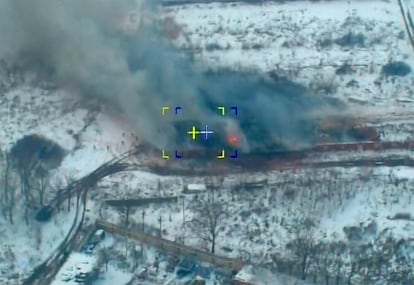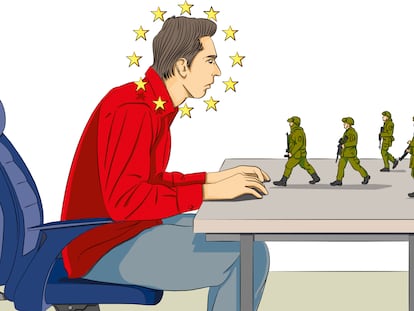Russia’s Kinzhal hypersonic missile: What is it and how does it work?
Moscow has confirmed it has used ‘new generation’ weapons in the war on Ukraine, which are capable of hitting targets at over 1,200 miles and carrying nuclear payloads


The Russian Ministry of Defense has stated that it deployed hypersonic missiles to attack objectives in Ukraine last weekend. The first use in the ongoing war of this kind of weapon, which was confirmed by US intelligence, represents a new phase in Russia’s ramping up of its military operations in the conflict given the capabilities of these missiles, known as Kinzhals, which have a range of over 1,200 miles and can carry a nuclear payload.
What is a Kinzhal?
The Kh-47M2 Kinzhal (which means “dagger” in Russian) is a Russian-made nuclear capable hypersonic aero-ballistic air-to-surface missile, which is able to perform evasive maneuvers in flight. A Kinzhal is eight meters long and can reach Mach 10, which is 10 times faster than the speed of sound (Mach 5 to Mach 10 speeds are classified as hypersonic). The missile weighs 9,500 pounds (4,300 kilograms) and can carry a conventional or nuclear payload of up to 1,110 lb (480kg), according to the Center for Strategic and International studies. A July 2018 report by the Russian TASS news agency suggested that a Kinzhal can achieve a range of over 1,800 miles (2,000 km) if launched from a Tupolev Tu-22M strategic bomber.
Can Kinzhals be intercepted by anti-missile systems?
Once launched, a Kinzhal rapidly achieves Mach 4 (3,000 miles per hour) and can reach speeds of up to Mach 10 (7,600mph). These speeds, combined with the missile’s erratic flight trajectory and its extreme maneuverability, make interception extremely difficult.
When did Russia develop the Kinzhal?
The Kinzhal was one of six “new generation” weapons unveiled by Vladimir Putin during a speech on March 1, 2018, when the Russian president said it was Moscow’s response to the US’s decision in 2002 to abandon the 1972 Anti-Ballistic Missile Treaty, a bilateral agreement between the Soviet Union and US and considered the cornerstone of the mutual containment system. Putin said Kinzhals had already been installed in Russia’s southern military district, an area that includes the Black Sea. A few days later, on March 11, Russian media published images of a test launch of a Kinzhal from a modified supersonic MiG-31. Although the video did not show the missile’s final impact, the Russian Ministry of Defense described the test a “success.”
▫️Destruction of a weapons depot of the Armed Forces of Ukraine by high-precision missile weapons strike. We can see the exact hit of an underground hangar with weapons and ammunition. pic.twitter.com/sKTF46Tdb0
— Минобороны России (@mod_russia) March 19, 2022
Have Kinzhals been used in combat?
The Russian Ministry of Defense said on Saturday that Moscow had used a hypersonic Kinzhal missile for the first time, in order to destroy “a large underground warehouse of missiles and aviation ammunition” in Deliatyn, eastern Ukraine. On Sunday, the Kremlin said it deployed further Kinzhals in an attack on a military base in the Zhytomyr region in northwestern Ukraine, near the border with Belarus. Moscow said that the base was hosting “over 100 Ukrainian special forces personnel and foreign mercenaries.” US officials including President Joe Biden, quoted by CNN, confirmed that Russia had deployed hypersonic missiles for the first time in combat. “In all likelihood, they intended to test the weapons and to send a message to the West,” the sources said.
What are the implications of Russia’s use of hypersonic missiles?
US Secretary of Defense Lloyd Austin on Sunday said he did not see the use of Kinzhal missiles in the Russia-Ukraine war as a “game-changer,” despite Saturday’s launches hitting targets just 180 miles (300km) from the Polish border and NATO territory. “I think the reason he is resorting to using these types of weapons is because he is trying to re-establish some momentum,” Austin said of Putin on CBS’ “Face the Nation” program last Sunday. “We’ve seen him attack towns and cities and civilians outright. We expect to see that continue. But I don’t think that this in and of itself will be a game changer.” What the Pentagon chief did say would constitute a “very serious step” on Russia’s part would be the use of chemical or biological weapons. I think if a chemical or biological weapon was used, you would see a significant reaction from not only the United States, but also the global community,” Austin said.
Tu suscripción se está usando en otro dispositivo
¿Quieres añadir otro usuario a tu suscripción?
Si continúas leyendo en este dispositivo, no se podrá leer en el otro.
FlechaTu suscripción se está usando en otro dispositivo y solo puedes acceder a EL PAÍS desde un dispositivo a la vez.
Si quieres compartir tu cuenta, cambia tu suscripción a la modalidad Premium, así podrás añadir otro usuario. Cada uno accederá con su propia cuenta de email, lo que os permitirá personalizar vuestra experiencia en EL PAÍS.
¿Tienes una suscripción de empresa? Accede aquí para contratar más cuentas.
En el caso de no saber quién está usando tu cuenta, te recomendamos cambiar tu contraseña aquí.
Si decides continuar compartiendo tu cuenta, este mensaje se mostrará en tu dispositivo y en el de la otra persona que está usando tu cuenta de forma indefinida, afectando a tu experiencia de lectura. Puedes consultar aquí los términos y condiciones de la suscripción digital.
More information
Últimas noticias
Sinaloa Cartel war is taking its toll on Los Chapitos
Venezuela hardens its ‘revolutionary state’ project amid pressure from Trump
Sydney Sweeney, the actress praised by Trump: ‘Women are up against what society wants them to be’
The Bolsonaro surname: An advantage or liability in Brazil’s 2026 presidential elections?
Most viewed
- Reinhard Genzel, Nobel laureate in physics: ‘One-minute videos will never give you the truth’
- Pablo Escobar’s hippos: A serious environmental problem, 40 years on
- Charles Dubouloz, mountaineering star, retires at 36 with a farewell tour inspired by Walter Bonatti
- Why we lost the habit of sleeping in two segments and how that changed our sense of time
- The fall of a prolific science journal exposes the billion-dollar profits of scientific publishing










































